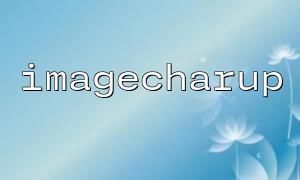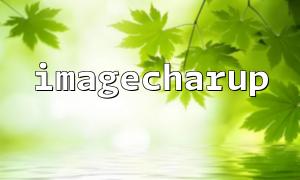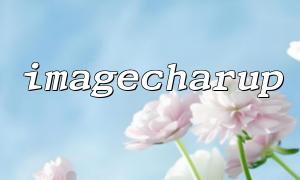In PHP's GD library, imagecharup() is a less commonly used but very practical function in certain image processing scenarios. It vertically draws a character from bottom to top on an image. However, during dynamic image generation and character rendering, improper use of this function can become a performance bottleneck. This article explores common performance issues with imagecharup() and provides optimization suggestions.
imagecharup() can only draw one character at a time. Therefore, if you need to output a piece of text, such as a sentence or a paragraph, the function must be called multiple times. Frequent calls within loops can significantly degrade performance, especially when generating a large number of images or in high-concurrency scenarios.
Manifestation: The longer the text, the more noticeable the increase in image generation time.
This function uses GD library's predefined fonts, which are fixed and relatively small. It does not support custom fonts or sizes, limiting control over character output density. To achieve larger glyphs or higher clarity, you may need to generate a larger canvas, consuming more memory.
Manifestation: Low content density requires enlarging the image, resulting in higher memory usage.
During bulk image generation, if images are repeatedly created and destroyed instead of reusing existing resources, or if resources are not properly freed, it can lead to memory leaks or resource exhaustion, reducing performance.
Manifestation: PHP script execution time increases, potentially causing memory overflow errors.
Although imagecharup() does not directly handle alpha channels, if the output image contains transparent layers, extra processing may be required during image composition. This issue becomes more pronounced when rotating or blending text.
Manifestation: Performance drops and rendering time increases when handling complex image compositions.
For repeatedly generated content, such as fixed titles or label images, it is recommended to pre-generate static images and save them with a caching mechanism to avoid redrawing each time.
<span><span><span class="hljs-keyword">if</span></span><span> (!</span><span><span class="hljs-title function_ invoke__">file_exists</span></span><span>(</span><span><span class="hljs-string">'cache/title.png'</span></span><span>)) {
</span><span><span class="hljs-variable">$im</span></span><span> = </span><span><span class="hljs-title function_ invoke__">imagecreate</span></span><span>(</span><span><span class="hljs-number">200</span></span><span>, </span><span><span class="hljs-number">50</span></span><span>);
</span><span><span class="hljs-variable">$white</span></span><span> = </span><span><span class="hljs-title function_ invoke__">imagecolorallocate</span></span><span>(</span><span><span class="hljs-variable">$im</span></span><span>, </span><span><span class="hljs-number">255</span></span><span>, </span><span><span class="hljs-number">255</span></span><span>, </span><span><span class="hljs-number">255</span></span><span>);
</span><span><span class="hljs-variable">$black</span></span><span> = </span><span><span class="hljs-title function_ invoke__">imagecolorallocate</span></span><span>(</span><span><span class="hljs-variable">$im</span></span><span>, </span><span><span class="hljs-number">0</span></span><span>, </span><span><span class="hljs-number">0</span></span><span>, </span><span><span class="hljs-number">0</span></span><span>);
</span><span><span class="hljs-title function_ invoke__">imagecharup</span></span><span>(</span><span><span class="hljs-variable">$im</span></span><span>, </span><span><span class="hljs-number">5</span></span><span>, </span><span><span class="hljs-number">10</span></span><span>, </span><span><span class="hljs-number">40</span></span><span>, </span><span><span class="hljs-string">'Hello'</span></span><span>, </span><span><span class="hljs-variable">$black</span></span><span>);
</span><span><span class="hljs-title function_ invoke__">imagepng</span></span><span>(</span><span><span class="hljs-variable">$im</span></span><span>, </span><span><span class="hljs-string">'cache/title.png'</span></span><span>);
</span><span><span class="hljs-title function_ invoke__">imagedestroy</span></span><span>(</span><span><span class="hljs-variable">$im</span></span><span>);
}
</span></span>When drawing complex text or needing font control, it is recommended to use imagettftext(). This function supports custom fonts, sizes, angles, and more rendering options. Although slightly more complex, it offers higher efficiency and better scalability.
<span><span><span class="hljs-title function_ invoke__">imagettftext</span></span><span>(</span><span><span class="hljs-variable">$im</span></span><span>, </span><span><span class="hljs-number">12</span></span><span>, </span><span><span class="hljs-number">90</span></span><span>, </span><span><span class="hljs-number">50</span></span><span>, </span><span><span class="hljs-number">150</span></span><span>, </span><span><span class="hljs-variable">$black</span></span><span>, </span><span><span class="hljs-string">'Arial.ttf'</span></span><span>, </span><span><span class="hljs-string">'Hello'</span></span><span>);
</span></span>Combine multiple characters and draw them at once to avoid calling the function for each character. For example, construct the string first and then render it using a function that supports full text blocks.
Dynamically set canvas size and character starting position based on the number of characters to prevent overflow and unnecessary blank areas, thereby saving memory.
Ensure the GD library is up to date, enable PHP opcode caching (such as Opcache), and appropriately increase memory limits and maximum execution time to improve overall performance.
Although imagecharup() is a simple function, it can still become a performance bottleneck if not optimized. By caching static content, replacing it with more efficient functions, optimizing image resource management, and controlling the rendering process, its performance can be significantly improved. In practice, choosing the right image processing function and strategy is more important than blindly calling functions.





